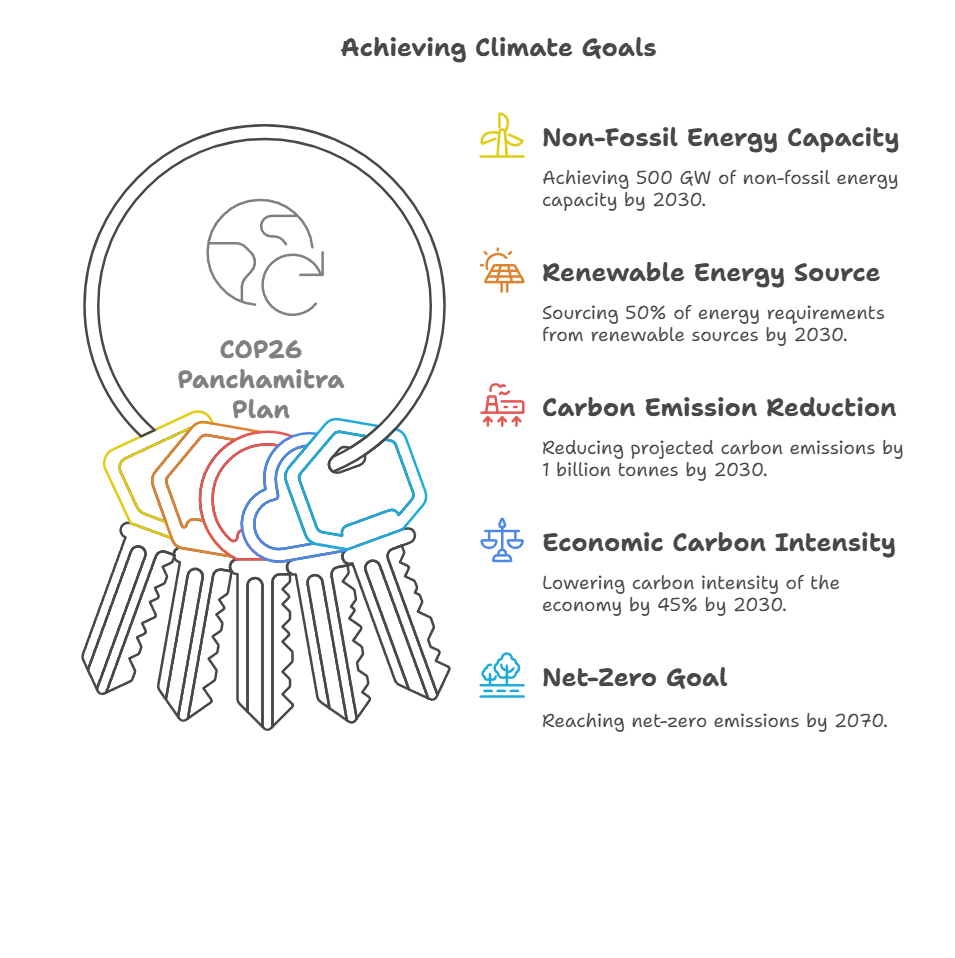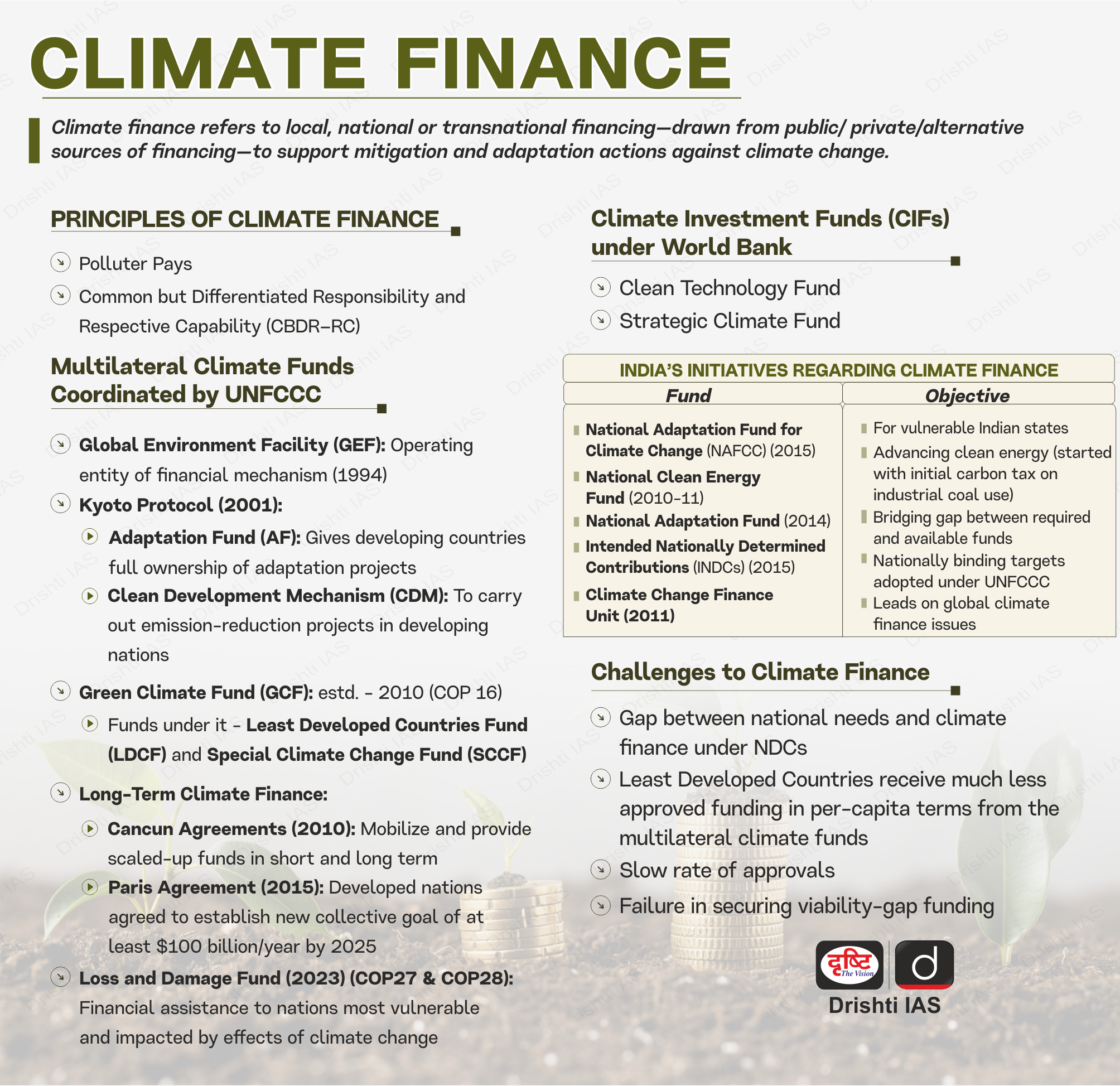AI Revolution in Indian Agriculture
For Prelims: Artificial Intelligence, Project Farm Vibes, Per Drop More Crop, Internet of things, AgriStack Initiative, PM-WANI
For Mains: AI in Sustainable Agriculture and Climate Resilience, Digital Agriculture Mission
Why in News?
Microsoft Chairman Satya Nadella recently highlighted the transformative impact of Artificial Intelligence (AI) in agriculture through Project Farm Vibes (PFV) in Baramati, Maharashtra, which has boosted crop yields by 40% while reducing resource consumption.
What is the Project Farm Vibes?
- About: Project Farm Vibes, developed by Microsoft Research with the Agricultural Development Trust, Baramati (MH), is an open-sourced AI suite of farm-focused technologies transforming farming with data-driven insights, empowering researchers, farmers.
- Technologies Used:
- Azure Data Manager for Agriculture: Aggregates satellite, weather, and sensor data for a holistic view of field conditions.
- FarmVibes.AI: Uses AI to analyze soil moisture, temperature, humidity, and pH for precise farming recommendations.
- Agripilot.AI: Offers real-time, actionable insights for sustainable farming and generates personalized recommendations in local languages.
- Impact: 40% increase in crop production, with healthier and more resilient crops.
- 25% reduction in fertiliser costs through precise, AI-guided spot fertilization.
- 50% less water consumption, promoting sustainable irrigation.
- 12% decrease in post-harvest wastage, improving profitability.
- Reduced chemical runoff, soil erosion, and greenhouse gas emissions and deforestation, leading to environmental benefits.
How is AI Revolutionizing Indian Agriculture?
- Smart Irrigation: Water scarcity is a significant challenge in Indian agriculture. AI is addressing this issue through Soil moisture and climate analysis to optimize irrigation schedules.
- AI-integrated drip and sprinkler irrigation systems under the "Per Drop More Crop" scheme, improving water efficiency.
- IoT-based irrigation solutions, developed by ICAR, which automate water supply based on real-time field conditions, reducing wastage.
- Pest & Weed Control: The National Pest Surveillance System, which leverages AI to monitor pest activity and provide real-time alerts.
- Automated weed detection, where AI-powered computer vision distinguishes weeds from crops and applies herbicides only where needed, reducing chemical usage.
- Economic Impact of AI in Agriculture: The AI in agriculture market is expected to grow from USD 1.7 billion in 2023 to USD 4.7 billion by 2028 at a CAGR of 23.1%, driven by advancements in precision farming, drone analytics, and labour management.
- Kisan e-Mitra, an AI-powered chatbot assisting farmers with queries about the PM Kisan Samman Nidhi scheme.
What Challenges Does AI Adoption in Agriculture Face?
- Lack of Awareness: Many farmers, especially in rural India, lack digital literacy to use AI-based tools effectively hindering large-scale adoption.
- High Implementation Costs: AI solutions like drones, Internet of things (IoT) sensors, and automated irrigation systems require significant investment.
- Small and marginal farmers, who make up 85% of India's farming community, struggle with affordability.
- Infrastructure Gaps: Unreliable internet connectivity in rural areas restricts access to AI-powered platforms.
- Out of 5,97618 inhabited villages in the country, 25067 villages lack mobile connectivity and Internet.
- Data Availability and Quality: AI relies on real-time and historical data for accurate predictions. Incomplete or inaccurate agricultural data limits AI’s effectiveness.
- Limited Customization: Most AI models are not tailored to India's diverse agro-climatic conditions.
- More research is needed to develop region-specific AI solutions.
Way Forward
- Data Frameworks: The AgriStack Initiative and India Digital Ecosystem for Agriculture (IDEA) can be utilized as digital platforms for farm data management, enabling accurate predictions through seamless data integration.
- Utilize the National AI Centres of Excellence on developing region-specific AI solutions for Indian agriculture.
- Digital Infrastructure: Public Wi-Fi hotspots under the Prime Minister's Wi-Fi Access Network Interface (PM-WANI) and BharatNet Project can enhance rural connectivity, enabling farmers to access AI-driven platforms.
- Skilling and Awareness: The National e-Governance Plan in Agriculture (NeGPA) educates farmers on AI applications, while FutureSkills PRIME, reskills professionals in AI and emerging technologies for agriculture.
- Financial Support: Under the Digital Agriculture Mission (2021-2025), offer subsidized loans to agri-tech startups and farmer cooperatives, promoting innovation in farming.
|
Drishti Mains Question: Discuss how Artificial Intelligence (AI) is transforming Indian agriculture. What are the key benefits and challenges associated with AI adoption in farming? |
UPSC Civil Services Examination, Previous Year Question (PYQ)
Prelims
Q. In the context of India’s preparation for Climate -Smart Agriculture, consider the following statements: (2021)
- The ‘Climate-Smart Village’ approach in India is a part of a project led by the Climate Change, Agriculture and Food Security (CCAFS), an international research programme.
- The project of CCAFS is carried out under Consultative Group on International Agricultural Research (CGIAR) headquartered in France.
- The International Crops Research Institute for the Semi-Arid Tropics (ICRISAT) in India is one of the CGIAR’s research centres.
Which of the statements given above are correct?
(a) 1 and 2 only
(b) 2 and 3 only
(c) 1 and 3 only
(d) 1, 2 and 3
Ans: (d)
Mains
Q. Explain various types of revolutions, took place in Agriculture after Independence in India. How these revolutions have helped in poverty alleviation and food security in India? (2017)
National Green Financing Institution
For Prelims: NaBFID, NABARD, IREDA, InvITs, Panchamrit Strategy, Green Bonds, Clean Environment Cess, Priority Sector Lending (PSL), Green Masala Bonds, COP29 UNFCCC,Credit Ratings.
For Mains: Need of a dedicated green financing institution in India. Role of finance in climate change mitigation.
Why in News?
The Government is working to set up a National Green Financing Institution to aggregate green finance from different sources and lower the cost of capital to support its net-zero target by 2070.
- NITI Aayog is evaluating models like NaBFID/NABARD, IREDA, Green InvITs, and global Green Banks for a National Green Financing Institution.
What is the Need for Green Finance in India?
- Escalating Climate Change Risks: Climate change could lead to an estimated 10% loss in total economic value and up to 18% of global GDP wiped out by 2050.
- This economic threat is particularly severe for India, which aims to grow its economy to USD 10 trillion by 2030.
- India's Net-Zero Ambitions: At COP26 UNFCCC, India pledged to achieve net-zero emissions by 2070 under the Panchamrit strategy that requires over USD 10 trillion in investments.
- Threat to Financial Institutions: The financial services industry faces 72% of the potential financial impact of climate change, which banks can mitigate by funding green infrastructure, renewable energy, energy-efficient buildings, and industrial decarbonization.
- Investment Deficit: India needs USD 1.4 trillion in aggregate investments, or USD 28 billion annually, to reach its 2070 net-zero goal.
- As of February 2023, India’s green bond issuances totaled USD 21 billion only, with the private sector contributing 84%.
What are the Current Green Energy Financing Initiatives in India?
- NCEEF: National Clean Energy and Environment Fund (NCEEF) funds clean energy ventures and research through Clean Environment Cess on coal.
- IREDA uses part of the NCEEF fund to lend to banks at the rate of 2%, enabling concessional loans for renewable energy projects.
- IREDA also sources funds from global banks e.g., the World Bank gave USD 100 million for solar parks.
- IREDA uses part of the NCEEF fund to lend to banks at the rate of 2%, enabling concessional loans for renewable energy projects.
- Recognition of PSL: In April 2015, RBI classified renewable energy as a priority sector lending (PSL), requiring banks to allocate up to 40% of net credit.
- Loans up to Rs 15 crore per borrower is given to cover solar, biomass, wind, micro-hydel, and non-conventional energy utilities.
- Green Banks: Green banks accelerate clean energy financing by funding environmentally sustainable projects.
- In India, IREDA, SBI and other banks offer concessional loans for renewable energy projects.
- Green Bonds: They are market-based financial instruments for raising capital for environmentally beneficial projects. E.g., Green Masala Bonds by IREDA.
- Crowdfunding: It is a decentralized funding model using small private investments for renewable energy. E.g., Crowdfunding platform Bettervest’s support for MeraGao Power and Boond Engineering in rural India.
What are Challenges in Green Energy Financing in India?.
- Limited International Finance: At COP29 UNFCCC, developed nations pledged to mobilize at least USD 300 billion annually by 2035 to support climate mitigation that is insufficient compared to the required financing.
- Several experts highlight that mobilising USD 1 trillion per year by 2030 is required to help developing countries cope with climate change.
- High Borrowing Costs: High interest rates, long gestation period and a lack of fiscal incentives for lenders make green finance costly, often rendering projects financially unviable.
- Diversion of Funds: NCEEF was created for clean energy initiatives, but much of its funds have been diverted to non-renewable projects like GST compensation and Namami Gange.
- Institutional Barriers for Green Banks: India has yet to institutionalize green banks due to a lack of clear RBI guidelines and legal recognition, impacting their credibility and fund mobilization.
- Underdeveloped Green Bond Market: Green bonds need high credit ratings, which many renewable projects lack due to poor financial health. Investor skepticism persists over fund utilization.
Way Forward
- Enhancing Climate Finance: Leverage platforms like the Global Green Bond Market and multilateral institutions (World Bank, AIIB) to mobilize concessional funding.
- Provide sovereign guarantees and interest rate subsidies for green infrastructure projects while introducing a Tax-Free Green Bond Scheme to attract investors.
- Green Banking Ecosystem: Institutionalize Green Banks under RBI with clear regulations and a legal framework, while promoting public-private co-financing to attract global green capital.
- Alternative Financing Mechanisms: Expand Green Infrastructure Investment Trusts (Green InvITs) to boost private participation and develop carbon credit markets linked to green financing instruments.
- Microfinancing: Support women-led green businesses and provide affordable climate risk insurance for small farmers to support adaptation rather than focusing only on mitigation.
|
Drishti Mains Question: Discuss the role of green finance in achieving India's net-zero target by 2070. What are the major challenges, and how can they be addressed? |
UPSC Civil Services Examination Previous Year Question (PYQ)
Prelims:
Q. Which of the following statements regarding ‘Green Climate Fund’ is/are correct? (2015)
- It is intended to assist developing countries in adaptation and mitigation practices to counter climate change.
- It is founded under the aegis of UNEP, OECD, Asian Development Bank and World Bank.
Select the correct answer using the code given below:
(a) 1 only
(b) 2 only
(c) Both 1 and 2
(d) Neither 1 nor 2
Ans: (a)
Mains
Q. Describe the major outcomes of the 26th session of the Conference of the Parties (COP) to the United Nations Framework Convention on Climate Change (UNFCCC). What are the commitments made by India in this conference? (2021)
Q. Explain the purpose of the Green Grid Initiative launched at the World Leaders Summit of the COP26 UN Climate Change Conference in Glasgow in November 2021. When was this idea first floated in the International Solar Alliance (ISA)? (2021)
Disaster Risk and Resilience Assessment Framework (DRRAF)
For Prelims: Telecom Service Providers, Department of Telecommunications (DoT), Coalition for Disaster Resilient Infrastructure (CDRI),
For Mains: DDRAF Recommendations for Strengthening Telecom Sector, Major Growth Drivers of the Telecom Sector in India, Major Challenges Related to the Telecom Sector in India.
Why in News?
The Department of Telecommunications (DoT) in collaboration with the Coalition for Disaster Resilient Infrastructure (CDRI) has launched a report on the Disaster Risk and Resilience Assessment Framework (DRRAF).
- The report, part of CDRI's study on National and Sub-national Disaster Risk & Resilience Assessment, aims to enhance the resilience of India’s telecom sector against natural disasters.
State of Telecom Infrastructure
- Telecom contributes 15% to global GDP and is projected to reach USD 2.8 trillion by 2030 (CAGR 6.2%).
- Disaster risks to infrastructure are rising globally and India is ranked 35th out of 191 countries in the UN INFORM Risk Index (2024-25).
- The UN INFORM Risk Index is a global, open-source risk assessment tool for humanitarian crises and disasters.
- India faces high vulnerability to earthquakes (58% land area), floods (12%), landslides (15%), and forest fires (10%), while 5,700 km of its coastline is at risk from cyclones and tsunamis.
What is Disaster Risk and Resilience Assessment Framework (DRRAF)?
- About DRRAF: Developed by CDRI, DoT, and NDMA, DDRAF adopts a system-scale approach covering all connectivity levels and regions.
- It aims to reduce infrastructure damage, financial losses, and enhance emergency connectivity and service restoration aligning with the Early Warnings for All (EW4All) by 2027’ initiative.
- EW4All was launched by the UN in 2022 to ensure global protection from climate-related disasters through early warning systems by year 2027.
- It assesses and proposes disaster resilience measures across 5 key dimensions:
- Technical Planning & Design: Strengthening telecom infrastructure.
- Operations & Maintenance: Ensuring service continuity.
- Policy, Institutions & Processes (PIPs): Integrating disaster resilience into governance.
- Financial Arrangements: Promoting risk-sharing mechanisms.
- Expertise: Enhancing sectoral capacity and knowledge exchange.
- It helps stakeholders identify and address disaster risks through targeted resilience measures.
- It aims to reduce infrastructure damage, financial losses, and enhance emergency connectivity and service restoration aligning with the Early Warnings for All (EW4All) by 2027’ initiative.
- Key Highlights of the Framework:
- At State Level: The study assesses disaster risks in the telecom sector across 5 states (Assam, Odisha, Tamil Nadu, Uttarakhand, and Gujarat).
- The study found that 100% of telecom infrastructure in Assam and Uttarakhand were exposed to earthquakes.
- 83% of towers in Assam and 57% of towers in Odisha and Tamil Nadu are affected by Cyclones.
- 43% of the towers of Assam are exposed to Floods, followed by Tamil Nadu (33%), Odisha and Gujarat.
- At National Level: A national assessment of 0.77 million telecom towers found 75% exposed to lightning, followed by cyclones (57%), earthquakes (27%), and floods (17%).
- Disaster Risk and Resilience Index (DRRI): A new index (DRRI) has been developed to assess telecom tower vulnerability across different terrains (mountain, plain, coast) based on intensity, frequency, duration, and spatial extent of hazards.
- At State Level: The study assesses disaster risks in the telecom sector across 5 states (Assam, Odisha, Tamil Nadu, Uttarakhand, and Gujarat).
- Challenges to Telecom Infrastructure:
- Structural Vulnerability: Telecom towers, especially in coastal areas, are prone to damage from high winds and cyclones.
- Overhead fiber-optic cables are more fragile than underground networks.
- Power Disruptions: Prolonged outages and fuel shortages for backup generators impact network functionality.
- Risk to Undersea Cables: Damage to undersea cable landing stations can disrupt national connectivity, with repairs requiring specialized equipment and time.
- Structural Vulnerability: Telecom towers, especially in coastal areas, are prone to damage from high winds and cyclones.
| Read More: What are the Major Challenges Related to the Telecom Sector in India? |
What are the Key Recommendations of the Report for Resilient Telecom Infrastructure?
- Enhancing Technical Planning & Design: Strengthen network redundancy, submarine cable protection, and seismic resilience of telecom towers.
- Improve interoperability, power backup for data centers, and fiber optic cable protection using common ducts in roads.
- Developing a Multi-Hazard Information Repository: Enhance disaster impact data collection, develop sub-district-level multi-hazard zonation maps, and identify critical telecom infrastructure for uninterrupted service.
- Risk-Informed Governance: Improve disaster forecasting, enforce resilient building codes and upgrade the Sanchar Saathi portal for grievance redressal.
- Developing Risk-Sharing Instruments: Introduce Parametric Insurance to enhance financial resilience of telecom operators by providing predefined payouts based on disaster triggers, ensuring faster recovery.
- Enhance Stakeholder Collaboration: By creating a knowledge-sharing platform, uninterrupted power supply, and establishing dedicated telecom infrastructure at critical industrial zones and disaster shelters.
| Read More: What Measures can be Adopt to Revamp India's Telecom Sector? |
|
Drishti Mains Question: Discuss the vulnerabilities of India’s telecom sector to natural disasters and suggest measures to enhance its resilience. |
UPSC Civil Services Examination, Previous Year Question (PYQ)
Prelims:
Q. In India, which of the following review the Independent regulators in sectors like telecommunications, insurance, electricity, etc.? (2019)
- Ad Hoc Committees set up by the Parliament
- Parliamentary Department Related Standing Committees
- Finance Commission
- Financial Sector Legislative Reforms Commission
- NITI Aayog
Select the correct answer using the code given below:
(a) 1 and 2
(b) 1, 3 and 4
(c) 3, 4 and 5
(d) 2 and 5
Ans: (a)
Q. In India, the term “Public Key Infrastructure” is used in the context of (2020)
(a) Digital security infrastructure
(b) Food security infrastructure
(c) Health care and education infrastructure
(d) Telecommunication and transportation infrastructure
Ans: (a)
Q. Which of the following is/are the aims/aims of the “Digital India” Plan of the Government of India? (2018)
- Formation of India’s own Internet companies like China did.
- Establish a policy framework to encourage overseas multinational corporations that collect Big Data to build their large data centres within our national geographical boundaries.
- Connect many of our villages to the Internet and bring Wi-Fi to many of our schools, public places and major tourist centres.
Select the correct answer using the code given below:
(a) 1 and 2 only
(b) 3 only
(c) 2 and 3 only
(d) 1, 2 and 3
Ans: (b)
NSO Time Use Survey 2024
Why in News?
The National Statistics Office (NSO), under the Ministry of Statistics and Programme Implementation (MoSPI), has released Time Use Survey (TUS) 2024, the second such nationwide survey after the first conducted in 2019.
- The survey highlights rising women's employment, greater male caregiving, and increased leisure time, signaling evolving gender roles in India.
Note: The TUS tracks time allocation across paid and unpaid activities, providing detailed insights into various aspects of daily life, unlike traditional surveys that focus on specific aspects of work.
- Conducted in India, Australia, Japan, Korea, the US, and China, it analyzes gender participation in work, caregiving, learning, and leisure.
What are the Key Findings of TUS 2024?
- Employment Participation: 75% of males and 25% of females (aged 15-59 years) participated in employment-related activities in 2024, compared to 70.9% males and 21.8% females in 2019.
- A reduction in time spent by women in unpaid domestic work (from 315 minutes/day in 2019 to 305 minutes/day in 2024) indicates a shift from unpaid to paid activities.
- Urban women showed a higher rise in employment participation compared to rural women, possibly due to better job opportunities, education, and support systems.
- Caregiving: 41% of women participated in caregiving compared to 21.4% of men in the 15-59 age group.
- Women spent 140 minutes/day on caregiving, compared to 74 minutes/day by male, while caregiving remains female-dominated, male participation has increased.
- Greater paternal involvement in child-rearing and elder care is emerging, influenced by changing gender roles and urbanization.
- Women spent 140 minutes/day on caregiving, compared to 74 minutes/day by male, while caregiving remains female-dominated, male participation has increased.
- Cultural, Leisure and Education Activities: People aged 6 years and above spent 11% of their daily time on cultural, leisure, mass media, and sports in 2024, compared to 9.9% in 2019.
- 89.3% of children (6-14 years) participated in learning activities, dedicating an average of 413 minutes/day to education.
- Household Production: About 16.8% of the population participated in producing goods for their own final use.
National Statistics Office (NSO)
- About: The NSO serves as the nodal agency for statistical development in India, ensuring standardization, coordination, and dissemination of data.
- NSO consists of the Central Statistical Office (CSO), the Data Informatics & Innovation Division (DIID) and the National Sample Survey Office (NSSO).
- Functions: NSO compiles and releases the Index of Industrial Production (IIP), conducts the Annual Survey of Industries (ASI), and provides statistical insights on industrial growth and economic trends.
|
Drishti Mains Question: How does the Time Use Survey (TUS) 2024 reflect changing gender roles in India? |
SWAYATT Initiative
Why in News?
Government E-Marketplace (GeM) celebrated the 6th anniversary of the SWAYATT (Startups, Women & Youth Advantage through e-Transactions) initiative.
What is the SWAYATT Initiative?
- About: It was launched in 2019 to enhance the market access for women entrepreneurs, youth, startups, Micro & Small Enterprises (MSEs), and Self-Help Groups (SHGs).
- It enhances seller inclusion through training, registration, and capacity-building to leverage GeM for market access and growth.
- Achievements:
- Women-led enterprises and startups have grown significantly, increasing from 6,300 women-led MSEs and 3,400 startups at launch to 1,77,786 Udyam-verified women MSEs.
- Women-led businesses now constitute 8% of GeM’s seller base.
- GeM facilitated Rs 35,950 Crore worth of orders from startups, addressing challenges in market access, finance, and value addition.
- It aims to double women entrepreneurs, increase their procurement share (currently 3.78%), and onboard 1 lakh DPIIT- registered startups.
- MoU was signed between GeM & FICCI Ladies Organisation (FICCI-FLO) to train and onboard 9,500+ women entrepreneurs, ensuring direct market linkages and boosting inclusive growth.
- “Startup Runway” and “Womaniya” storefronts were included to enhance visibility for startups, women entrepreneurs, and youth among government buyers.
- Women-led enterprises and startups have grown significantly, increasing from 6,300 women-led MSEs and 3,400 startups at launch to 1,77,786 Udyam-verified women MSEs.
What is Government e-Marketplace (GeM)?
- GeM is the public procurement portal for Central & State Governments, PSUs, and affiliated entities to procure goods and services.
- It serves as India’s National Procurement Portal.
- It was established in 2016 under the Directorate General of Supplies and Disposals (DGS&D), Ministry of Commerce and Industry with technical support from the National e-Governance Division (MeitY).
- It is a paperless, cashless, and system-driven platform that minimizes human intervention in public procurement.
UPSC Civil Services Examination, Previous Year Question:(PYQ)
Prelims:
Q.1 What is/are the recent policy initiative(s)of Government of India to promote the growth of the manufacturing sector? (2012)
- Setting up of National Investment and Manufacturing Zones
- Providing the benefit of ‘single window clearance’
- Establishing the Technology Acquisition and Development Fund
Select the correct answer using the codes given below:
(a) 1 only
(b) 2 and 3 only
(c) 1 and 3 only
(d) 1, 2 and 3
Ans: (d)
Q.2. Which of the following can aid in furthering the Government’s objective of inclusive growth? (2011)
- Promoting Self-Help Groups
- Promoting Micro, Small and Medium Enterprises
- Implementing the Right to Education Act
Select the correct answer using the codes given below:
(a) 1 only
(b) 1 and 2 only
(c) 2 and 3 only
(d) 1, 2 and 3
Ans: (d)
Death Anniversary of VD Savarkar
The Prime Minister paid tributes to VD Savarkar on his death anniversary on 26th February 2025. He passed away in Mumbai on 26th February 1966.
- About VD Savarkar: He was a nationalist, revolutionary, and writer who played a key role in India's independence and shaped nationalist ideology.
- Political Ideology:
- Hindutva: Defined Hindu nationalism, arguing for a cultural and civilizational identity of India as a Hindu Rashtra.
- Hindu Mahasabha Leadership (1937-1943): Advocated against partition and promoted military training for Hindus.
- Revolutionary Activities:
- Founded Abhinav Bharat Society (Young India Society, 1904): A secret revolutionary group advocating armed resistance against British rule.
- Associated with India House & Free India Society: Played a crucial role in fostering revolutionary activities among Indian students in London.
- Book on 1857 Revolt (1909): His work, The First War of Indian Independence - 1857, redefined the 1857 uprising as a nationalist struggle.
- Imprisonment (1911-1924): Arrested for conspiring against British rule, he was sentenced to 50 years at Kala Pani in Andaman Cellular Jail.
- He was released in 1924 after writing a few mercy petitions between 1911 and 1920 for his release.
| Read More: Veer Savarkar |
94th Martyrdom Day of Chandra Shekhar Azad
Political leaders across parties paid heartfelt tributes to freedom fighter Chandra Shekhar Azad on his 94th martyrdom day on 27th February 2025.
- About Chandra Shekhar Azad: He was a revolutionary freedom fighter known for his bravery, and his commitment to never being captured alive by the British.
- Role in Freedom Struggle: He was deeply impacted by the Jallianwala Bagh massacre (1919) and joined the freedom struggle at a young age.
- Joined NCM (1921) as a student and became a key member of the Hindustan Republican Association (HRA) after Gandhiji suspended NCM in 1922.
- Revolutionary Activities: Kakori Train Action (1925).
- Assassination of JP Saunders (1928) to avenge Lala Lajpat Rai's death.
- Attempted to blow up the Viceroy Lord Irwin's train in 1929.
- Legacy: He was martyred in a police encounter at Alfred Park, Allahabad (now Prayagraj) (27th February 1931) by shooting himself rather than being captured.
| Read More: Chandra Shekhar Azad |
Gallantry Award for ICG Personnel
The Defence Minister conferred gallantry, distinguished service, and meritorious service medals to Indian Coast Guard (ICG) personnel for their exemplary service.
- About Gallantry Awards: They honor bravery in the Armed Forces, other forces, and civilians and are announced on Republic Day and Independence Day.
- Order of precedence of the Award: Param Vir Chakra, Ashoka Chakra, Mahavir Chakra, Kirti Chakra, Vir Chakra, and Shaurya Chakra.
- About ICG: ICG is a maritime security force responsible for enforcing maritime laws and operates under the Ministry of Defence.
- It was established on 1st February 1977 and became an independent armed force on 18th August 1978 with the enactment of the Coast Guard Act, 1978.
- It has jurisdiction over the territorial waters (upto 12 nautical miles (nm)) including contiguous zone (upto 24 nm) and EEZ (up to 200 nm) of India.
- Also, it is the 4th largest Coast Guard in the world.
| Read More: Indian Coast Guard |
Spinal Muscular Atrophy
A 2.5-year-old girl is the first person in the world to receive treatment for Spinal Muscular Atrophy (SMA) before birth.
- About SMA: It is a genetic disorder affecting motor neurons, leading to progressive muscle weakening due to SMN1 (survivor motor neuron 1) gene mutation and protein deficiency.
- Occurrence: It affects one in every 10,000 births, making it a leading genetic cause of infant and child mortality.
- Gene Transfer: SMA occurs when both parents pass SMN1 gene mutations; they are usually carriers without symptoms.
- Impact: It primarily affects muscles, which don’t receive signals from nerve cells.
- Symptoms: Weakness in voluntary muscles (shoulders, hips, thighs), respiratory and swallowing difficulties, etc.
- Genetic disorders are medical conditions caused by abnormalities in an individual’s genes or chromosomes, either inherited or caused by DNA mutations.
| Read More: Genetic Disorders |
WASP-121b Exoplanet
Astronomers have mapped the 3D atmosphere of exoplanet WASP-121b (Tylos), located 900 light-years away, using the ESO’s VL Telescope, revealing complex weather patterns and chemical composition.
WASP-121b (Tylos):
- It is a gas giant exoplanet discovered in 2016, orbiting the yellow-white F-type star WASP-121.
- It has a size 1.87 times that of Jupiter and a mass 1.18 times greater.
- Type: It is an ultra-hot Jupiter (a gas giant orbiting its host star very closely), with an orbital period of just 30 Earth hours.
Key Findings:
- Extreme Climate Conditions: WASP-121b has extreme temperature contrasts due to tidal locking, with one hemisphere scorched and the other cooler, driving dynamic atmospheric patterns.
- Jet Streams and Wind Patterns: Powerful jet streams and winds with speeds, creating distinct atmospheric flows.
- Chemical Composition: Its atmosphere comprises iron, sodium, hydrogen, and titanium, with 3 distinct layers: iron winds at the base, a fast sodium jet stream, and hydrogen winds at the top, shaping its unique climate.
| Read More: Detection of Barium in the Exoplanet Atmospheres. |









